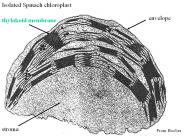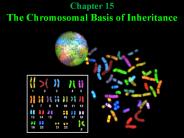Chloroplasts PowerPoint PPT Presentations
All Time
Recommended
Chloroplasts & Mitochondria *Compare and contrast the functions of chloroplasts and mitochondria The cellular machinery requires a coninuous energy supply to do all ...
| PowerPoint PPT presentation | free to download
Chloroplasts & Mitochondria *Compare and contrast the functions of chloroplasts and mitochondria The cellular machinery requires a coninuous energy supply to do all ...
| PowerPoint PPT presentation | free to download
... mutant with enhanced antioxidants (hp2) - shows enhanced plastid development, and - is defective in a repressors of photomorphogenesis (LsDET1) ...
| PowerPoint PPT presentation | free to download
They occur in large numbers in the palisade cells of the leaves of flowering plants. ... that are found in large quantities in the palisade cells of plants. ...
| PowerPoint PPT presentation | free to view
Basically they are the food producers of the cell. They are only found in plant ... http://users.rcn.com/jkimball.ma.ultranet/BiologyPages/C/Chloroplasts.html ...
| PowerPoint PPT presentation | free to view
SBS922 Membrane Biochemistry Mitochondria and chloroplasts John F. Allen School of Biological and Chemical Sciences, Queen Mary, University of London
| PowerPoint PPT presentation | free to download
1. Cells have chloroplasts. The green chlorophyll traps light energy. 2. This is the inside of a leaf. The top cells have many chloroplasts and no gaps. ...
| PowerPoint PPT presentation | free to download
MITOCHONDRIA AND CHLOROPLASTS Structure and function - a review The Exam Question Contrast and compare mitochondria and chloroplasts structure and function.
| PowerPoint PPT presentation | free to download
Chloroplasts Belong to the class of organelles known as the plastids. They are the sites for photosynthesis in plant cells and some forms of eukaryotic algae.
| PowerPoint PPT presentation | free to view
Targeting and assembly of proteins destined for chloroplasts and mitochondria How are proteins targeted to chloroplasts and mitochondria from the cytoplasm?
| PowerPoint PPT presentation | free to download
... Carotenoids reflect red and orange light Xanthophylls reflect yellow light Pigments and Light When wavelengths of visible light (white light) ...
| PowerPoint PPT presentation | free to view
Title: Slide 1 Last modified by: Jan Smalle Created Date: 2/2/2005 11:26:47 PM Document presentation format: On-screen Show (4:3) Company: home Other titles
| PowerPoint PPT presentation | free to download
Plastid Transcriptional Regulation. Transcriptional regulation is often global or ... Stability of some plastid mRNAs increases during greening (psbA), but most ...
| PowerPoint PPT presentation | free to view
Chloroplasts: Photosynthesis Machines Organelles found in algae and plant cells Convert energy of sunlight into chemical energy through photosynthesis
| PowerPoint PPT presentation | free to download
iron-sulfur centers: 5 or more in NADH dehydr. ... net export of - charge to cytosol as ATP is pumped out 'costs' one charge ...
| PowerPoint PPT presentation | free to view
sum total of all chemical changes that occur in cells. - each reaction is catalyzed by a ... 3. amphibolic pathway - used in both catabolism and anabolism. ...
| PowerPoint PPT presentation | free to view
That light via electron transport drives hydrogen ion transport. ... C4 - Photosynthesis. C4. CAM. Succulents. Cacti. Pineapple. CAM. Comparison of C4 and CAM ...
| PowerPoint PPT presentation | free to view
1. The difference between plant and animal cells is that animal cells contain a cell wall and chloroplasts. 2. The main source of energy for our bodies is protein.
| PowerPoint PPT presentation | free to view
The metal ion is responsible for the movement of the e-, skipping from one ion to another ... Iron-sulfur centers carry 1 e- at a time. Cytochrome b-c1 and ...
| PowerPoint PPT presentation | free to view
Scanning ? Some of the proteins that bind the 5' UTRs of mRNAs promote translation ... expressed poorly if plastids don't develop, or are damaged by photo-oxidation. ...
| PowerPoint PPT presentation | free to view
Chapter 14 Energy generation in Mitochondria and Chloroplasts Not responsible for 1) Detailed mechanism of the Ps reaction center (Figure 14-31)
| PowerPoint PPT presentation | free to view
Targeting and assembly of proteins destined for ... How do they get through the membranes? Two types of cytosolic ribosomes: free and membrane-bound. ...
| PowerPoint PPT presentation | free to view
... water ( light energy) glucose oxygen. Palisade cells have a lot of chloroplasts. ... Carbon dioxide diffuses into leaves through the stomata. ...
| PowerPoint PPT presentation | free to view
Comparison of chemiosmosis in mitochondria and chloroplasts. Peter Mitchell 1961 ... CAM plants are mainly desert-adapted succulents- cacti, etc. CAM plants ...
| PowerPoint PPT presentation | free to view
Import of the protein into the matrix is directed by an N-terminal signal sequence. ... Comparison of mitochondrial and nuclear import. ...
| PowerPoint PPT presentation | free to view
1) the details of redox relationships, free-energy changes during e-transport, ... Calvin / Bensen cycle -- RUBP carboxylase oxygenase (Rubisco) Photorespiration ...
| PowerPoint PPT presentation | free to view
Targeting to inner chloroplast compartments: thylakoid membrane and lumen ... OEC (or OE) proteins of PSII mediate water splitting: Found in thylakoid lumen ...
| PowerPoint PPT presentation | free to view
There appear to be three methods for recognising proteins destined for import. ... 1) It must recognise the signal on peptides projecting from the TOM complex ...
| PowerPoint PPT presentation | free to view
8.2 The Calvin cycle proceeds in three stages: carboxylation, reduction, and regeneration ... of the C2 oxidative photosynthetic cycle on chloroplast metabolism ...
| PowerPoint PPT presentation | free to view
Chloroplast genome: Evolution, structure and regulation of the gene expression Darin I. Peshev Chloroplasts Chloroplasts Development of chloroplasts Development of ...
| PowerPoint PPT presentation | free to view
... mitochondries Pr sence possible de chlorophylle h t rotrophe autotrophe si chloroplastes autotrophe si chlorophylle Pas de chloroplastes Pas de vacuole ...
| PowerPoint PPT presentation | free to view
Isolated Spinach chloroplast envelope thylakoid membrane stroma From Hoober Chloroplast RNA polymerases (RNAPs) Two different RNAPs in vascular plant chloroplasts ...
| PowerPoint PPT presentation | free to download
BOTANY The Study of the plant kingdom Examples Characteristics of Plant Kingdom Are multicellular eukaryotes that are photosynthetic autotrophs Contain chloroplasts ...
| PowerPoint PPT presentation | free to download
Cell Energy: Photosynthesis & Respiration Today s Learning Goals In plants, chlorophyll (found in chloroplasts) captures energy ...
| PowerPoint PPT presentation | free to view
... & water to make sugar & oxygen Contain chlorophyll Chloroplasts Cells Alive! 1.) Cells smallest living thing 2.) Tissues many cells working together ...
| PowerPoint PPT presentation | free to view
Chloroplast Organelle where photosynthesis takes place Contain chemical compounds called: Chlorophyll Leaf Structure Chloroplasts are concentrated in the mesophyll of ...
| PowerPoint PPT presentation | free to view
Chapter 10 Photosynthesis C3 C4 CAM Chapter 10 Photosynthesis How do the reactant molecules of photosynthesis reach the chloroplasts in leaves?
| PowerPoint PPT presentation | free to download
Plants Chapter 6 pp 113-131 Characteristics of Plants Plants have chloroplasts which contain chlorophyll Chlorophyll green chemical that traps light energy Make ...
| PowerPoint PPT presentation | free to view
chloroplast. Organelles continued... Endoplasmic reticulum. Organelles continued... Golgi body ... have chloroplasts or cell walls. Have chloroplasts and cell ...
| PowerPoint PPT presentation | free to view
Structure of the Plasma Membrane Lipid bilayer two sheets of lipids (phospholipids). Found around the cell, the nucleus, vacuoles, mitochondria, and chloroplasts.
| PowerPoint PPT presentation | free to download
Chapter 15 The Chromosomal Basis of Inheritance Chapter 15 The Chromosomal Basis of Inheritance Extranuclear Genes Mitochondria and chloroplasts contain some genes.
| PowerPoint PPT presentation | free to download
Summer work Chapters 1, 6 and 25 Chloroplasts Light energy to manufacture organic molecules Chlorophyll give plants green color Contain DNA Centrioles Barrel shaped ...
| PowerPoint PPT presentation | free to download
2.1 The Structure & Functions of Eukaryotic Cells Chloroplasts Derived from photosynthetic bacteria & has DNA A double membrane bound, solar energy capturing ...
| PowerPoint PPT presentation | free to download
By tracking radioactive C in CO2 through. time as it reacted with chloroplasts in algae. ... 3-PGA (a 3 carbon compound) Chloroplasts. Photosynthesis is basically the ...
| PowerPoint PPT presentation | free to download
Flowering Plants: Monocot versus Dicots 8-28-12 Plantae Kingdom Plants have: Cells Cell walls made of cellulose Chloroplasts which contain chlorophyll Roots, Leaves ...
| PowerPoint PPT presentation | free to download
WRITTEN FINAL REVIEW WHAT ARE SIMILARITIES AND DIFFERENCES BETWEEN CHLOROPLASTS AND MITOCHONDRIA? Mitochondria Chloroplast What kind of cell is it present in?
| PowerPoint PPT presentation | free to download
Kingdom Animalia Characteristics Heterotrophs Eukaryotic Multicellular No cell wall, no chloroplasts Motile Sense Organs 9 phyla we will mention Porifera sponges ...
| PowerPoint PPT presentation | free to download
Fig. 9-2 Light energy ECOSYSTEM Photosynthesis in chloroplasts Organic molecules CO2 + H2O + O2 Cellular respiration in mitochondria ATP ATP powers most cellular work
| PowerPoint PPT presentation | free to download
Chapter 6 Plants There are 350,000 species of plants Features chloroplasts chlorophyll---chemicals that give plants green color and trap light energy.
| PowerPoint PPT presentation | free to download
May originally have been transposons Conferred a benefit Became able to replicate autonomously Acquired genes to form a protein coat Mitochondria and chloroplasts ...
| PowerPoint PPT presentation | free to download
Chlorophyll a,b and carotenoids in chloroplasts. Starch stored inside chloroplasts ... B. Frith. M. Ayasse. Flowering plants. Anthophyta Characteristics ...
| PowerPoint PPT presentation | free to view
... Vacuoles In plants Chloroplasts Nucleus Largest structure in a cell Usually spherical membrane shell that houses DNA and makes RNA for use in directing protein ...
| PowerPoint PPT presentation | free to download
By Stephen Zevgolis. Introduction. Algae with golden chloroplasts, used for photosynthesis. ... These algae make up parts of the nanoplankton. ...
| PowerPoint PPT presentation | free to view
Photosynthesis biology 1 Photosynthesis plays a key role in photo-autotrophic existence Photosynthesis is a redox process, occurring in chloroplasts, and involves two ...
| PowerPoint PPT presentation | free to download
both plant-like (chloroplasts) and animal-like (active motion with ... Sebdenia flabellata. Giant Kelp. Giant kelp on beach, showing stipe, blade and bladder ...
| PowerPoint PPT presentation | free to download
Collenchyma unevenly thick primary walls used for plant support ... (parenchyma with chloroplasts); palisade (most photosynthesis) and spongy (gas circulation) ...
| PowerPoint PPT presentation | free to view
























































